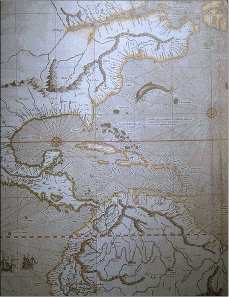Loxodrome
The shortest path between two points on the surface of the Earth is along a great circle arc, but this path is often not possible for ships. One reason is that a great circle arc takes constant changes of compass heading. Because it is not much longer in the middle latitudes, ships often sail a path of constant compass heading, called a loxodrome (and sometimes a rhumb line). Loxodrome comes from the Greek roots loxos for slanted, and drome which means path or course. The word rhumb was derived from the old Spanish term rumb for room or space, and the "h" seems to have crept in over confusion with the word rhombus. The first person to study the rhumb lines, and realize that they were not the shortest path between two points on the globe, was Pedro Nunez, the Portugese mathematician. In 1537, Nunez, the Royal Cosmographer of Portugal published his studies in Tratado da Sphera. In 1541 Gerard Mercator published the first globe with rhumb lines marked on it. The Globe was also the largest globe made up to that time. Today one of the globes may be found at the National Maritime Museum in Greenwich in Great Britain. Another is at the Harvard University Map Collection. You can view selected images of the globe at this web link.
The term "loxodrome" first appears in Tiphys batavus in 1624 by the Dutch Scientist Willebrord van Roijen Snell who is also known for his optical law of refraction.
Until the middle of the 18th century, finding a ships longitude at sea was nearly impossible. This forced seamen to try to navigate along a constant direction and use their estimated speed to "dead reckon" their position. It was 1569, almost 28 years after Mercator's use of rhumb lines on a globe, that he hit upon his most marvelous creation, a flat map in a new projection that would make navigation much easier, the type of map we now call a Mercator or cylindrical projection (at right). A straight line drawn on a Mercator projection map is a loxodrome.
The word loxodrome is also sometimes used for a logarithmic spiral because it always cuts a line through the origin with the same angle. A true complete loxodromic spiral on a sphere will endlessly circle the poles without reaching them. For that reason, the loxodrome is also called a spherical spiral.One of the first to show this was true was the English Mathematician Thomas Harriot. "He exhibited the logarithmic spiral as the stereographic projection of a loxodrome on a sphere, a projection he proved to be conformal." [St Andrews Univ math history web site
No comments:
Post a Comment